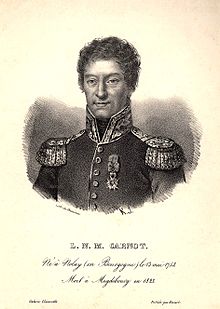Lazare Nicolas Marguerite, Comte Carnot | |
|---|---|
 Portrait by Louis-Léopold Boilly, 1813 | |
| 41st President of the National Convention | |
| In office 20 May 1794 – 4 June 1794 | |
| Preceded by | Robert Lindet |
| Succeeded by | Claude-Antoine Prieur-Duvernois |
| Member of the Committee of Public Safety | |
| In office 14 August 1793 – 6 October 1794 | |
| Director of the French Directory | |
| In office 4 November 1795 – 5 September 1797 | |
| Preceded by | None |
| Succeeded by | Philippe-Antoine Merlin de Douai |
| Minister of War | |
| In office 2 April 1800 – 8 October 1800 | |
| Preceded by | Louis-Alexandre Berthier |
| Succeeded by | Louis-Alexandre Berthier |
| Minister of Interior | |
| In office 20 March 1815 – 22 June 1815 | |
| Monarch | Napoleon I |
| Preceded by | François-Xavier-Marc-Antoine de Montesquiou-Fézensac |
| Succeeded by | Claude Carnot-Feulin |
| Personal details | |
| Born | 13 May 1753 Nolay, Burgundy, France |
| Died | 2 August 1823 (aged 70) Magdeburg, Saxony, Prussia |
| Resting place | Panthéon, Paris |
| Political party | Marais |
| Children | Sadi Carnot Lazare Hippolyte Carnot |
| Profession | Mathematician, engineer, military commander, politician |
| Signature |  |
| Military service | |
| Allegiance | |
| Branch/service | Army |
| Years of service | 1771–1815 |
| Rank | Divisional general |

Lazare Nicolas Marguerite, Comte Carnot (French pronunciation: [lazaʁ nikɔla maʁɡəʁit kaʁno]; 13 May 1753 – 2 August 1823) was a French mathematician, physicist, military officer, politician and a leading member of the Committee of Public Safety during the French Revolution. His military reforms, which included the introduction of mass conscription (levée en masse), were instrumental in transforming the French Revolutionary Army into an effective fighting force.
Carnot was elected to the National Convention in 1792, and a year later he became a member of the Committee of Public Safety, where he directed the French war effort as one of the Ministers of War during the War of the First Coalition. He oversaw the reorganization of the army, imposed discipline, and significantly expanded the French force through the imposition of mass conscription. Credited with France's renewed military success from 1793 to 1794, Carnot came to be known as the "Organizer of Victory".
Increasingly disillusioned with the radical politics of the Montagnards, Carnot broke with Maximilien Robespierre and played a role in the latter's overthrow on 9 Thermidor and subsequent execution. He became one of the five initial members of the Directory but was ousted after the Coup of 18 Fructidor in 1797 and went into exile.
Following Napoleon's rise to power, Carnot returned to France and in 1800 was briefly Minister of War. A fervent Republican, he chose to withdraw from public life after Napoleon's coronation as Emperor. In 1812, he returned to serve under Napoleon and oversaw the defense of Antwerp against the Sixth Coalition, and during the Hundred Days he was Napoleon's Minister of the Interior. Carnot was exiled after the second Bourbon Restoration and died in Magdeburg, Prussia in 1823.
In addition to his political career, Carnot was also an eminent mathematician. His 1803 Géométrie de position is considered a pioneering work in the field of projective geometry. He is also remembered for developing the Carnot wall, a system of fortification that became widely employed in continental Europe during the 19th century.